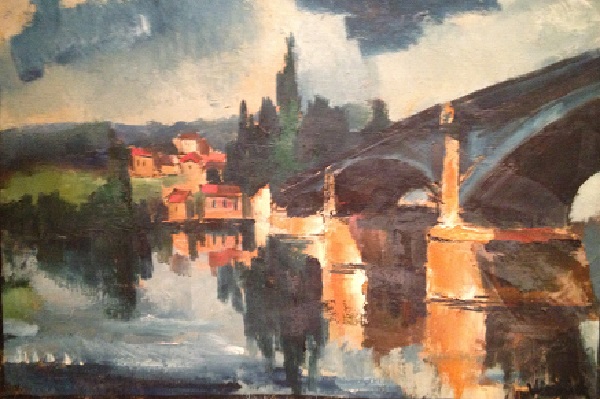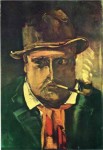
Maurice Vlaminck
French, 1876-1958
The Bridge, 1912 ca.
oil on canvas
19 1/2 × 28 3/4 in.
SBMA, Gift of The Joseph B. and Ann S. Koepfli Trust
2017.16.2

Maurice Vlaminck, Self Portrait with Pipe, n.d.
"Good painting is like good cooking: it can be tasted, but not explained. " - Maurice Vlaminck
COMMENTS
Maurice de Vlaminck (1876-1958) visited the Van Gogh exhibition in 1901 at the Galerie Bernheim-Jeune in Paris, and was so overcome that he proclaimed ‘Van Gogh is my father.’ After this experience, his art became more expressive and brilliantly colored, and he often painted directly from the tube. Vlaminck and his fellow artist André Derain, formed the Ecole de Chatou, named for a spot along the Seine where the artists often painted in plein air. In 1905, Vlaminck, André Derain, and Henri Matisse exhibited at the Salon d’Automne. The art critic Louis Vauxcelles famously described their work as ‘Donatello chez les fauves’ (Donatello among the wild beasts). The artists’ work in this style became known as Fauvism.
Maurice de Vlaminck’s most sought after paintings are his early works, particularly in the brilliantly colored Fauvist style, as well as transitional works showing Fauvist influence. Vlaminck is well known for his painting of bridges, especially the bridge of Chatou on the river Seine. The bridge in this painting has not been positively identified to date, but resembles the bridge at Chatou. The painting is consistent with his transitional style, also referred to as the Blue Period, from 1908-1914. Vlaminck was strongly affected by an exhibition of Cézanne’s paintings he attended in 1908, leading to an evolution of his style, known as his transitional period.
Vlaminck’s painting style began to evolve from Fauvism with its bright colors and expressive brushwork, and gradually became more influenced by impressionism. His palette changed to accentuate blues and browns.
The label of the Mayor Gallery on the reverse of the frame, gives the title as: Le Pont, 1912. The frame is also marked for the Mayor Gallery. Established by Fred Mayor in 1925, the Mayor Gallery was an important London venue for modernist art. Le Pont was purchased by Dr. Wood in 1932 from the Independent Gallery, sold at Sotheby’s Auction in November, 1964, to the Mayor Gallery, and subsequently purchased from the Mayor Gallery in June, 1965, by Frank Perls for the donee.
© 2018 Alice Karle Fine Art Appraiser, Charitable Donation Appraisal
https://www.alicekarleappraiserfineart.com/maurice-de-vlaminck/
SBMA CURATORIAL LABELS
Self-taught, Vlaminck's early work combined expressive, broad brushstrokes with the exuberant color of Fauvists such as André Derain and Henri Matisse, artists with whom he painted and exhibited. Following the 1907 Cézanne Retrospective held in Paris, Vlaminck fell under the spell of the recently deceased artist's palette, technique, and obsession with pure landscape. The Bridge is one such example, as seen in the more muted tones and constructivist brushwork of the composition, a decided turn away from the strident hues of the Fauves.
- Ridley-Tree Reinstallation, 2022
This luminous landscape reflects Vlaminck's early assimilation into the avant-garde: he draws from Paul Cezanne’s abstract but structured organization of pigment on canvas but also Henri Matisse's and Andre Derain's Fauvist experiments with intense, expressive color, often entirely liberated from realistic depiction. This painting was created toward the end of Vlarninck’s most adventurous Fauve phase, which lasted until the start of the First World War.
Vlaminck's early works first appeared in Nazi contexts at an exhibition organized in the German city of Ulm; they were displayed alongside their purchase prices - intended to mock the value given to modem art as absurd - and the names of art dealers, most of whom were Jewish, who bought the paintings. A portrait of the mayor of Ulm during the Weimar Republic also appeared in the show; the mayor had supported the Jewish museum director's decision to acquire modem art. In addition to re-contextualizing modem art to make it political, the National Socialists purged curators, art historians, and staff who did not subscribe to their ideology from German museums. Despite this disturbing history, Vlamink later traveled with Derain to the Third Reich, where he was recognized by the fascist regime.
- Fauvism to Fascism, 2018
